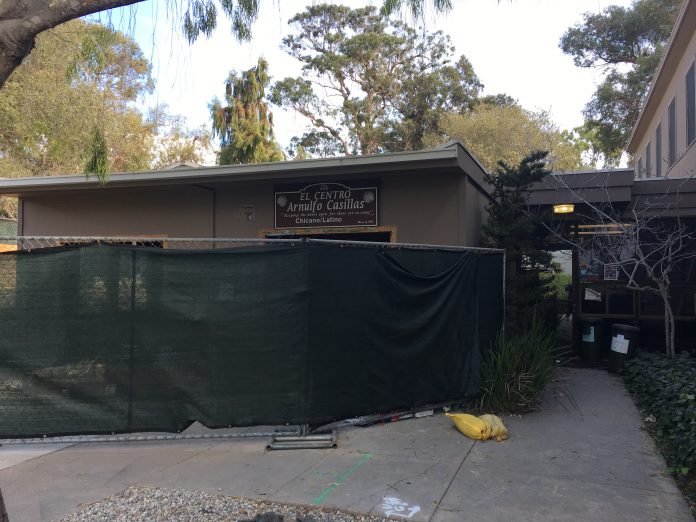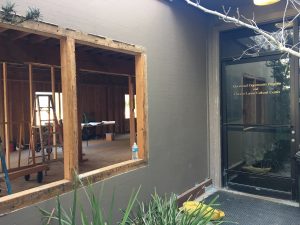
Shomik Mukherjee
News Editor
A construction project for El Centro, the historic hub for Latinx student groups on campus at the University of California, Santa Barbara, is slowly moving along, though occupants have at times taken some issue with both the personnel and the progress on the job.
Nearly 11 months after UCSB administrators first notified occupants about the structural problems plaguing the historic building, construction workers have added new restrooms and plywood to replace the dry rot that was previously corroding the building’s infrastructure. New televisions and furniture were also added to El Centro. Some of the building’s older chairs that were replaced had dated back several decades, fourth year English major Lorena Alvarez told The Bottom Line.
UCSB Design & Construction Services still plans to add new panels to the ailing interior walls but not without replicating culturally significant murals painted by generations past, according to minutes from a Nov. 7 project meeting. Windows and panels still need to be added to replace old structures. Occupants have also obtained $9,000 in funding from the Associated Students Senate to create card-readers on the doors of the building, as a security measure for El Centro regulars.
Construction was previously scheduled to finish in late July, but the project will not be completely finished until winter break.
Tensions between Latinx students and the university flared in January after a third-party construction group issued a 45-day “vacate notice” for the students, citing safety concerns. An eruption of pushback from El Centro occupants, who wanted to continue using the building through the end of the school year, prompted campus administrators to rescind the vacate notice and reschedule the project for mid-June.
“It shouldn’t have gotten to the point where our safety was at risk every time they met there,” Alvarez said. “If an earthquake had happened, who’s to say we wouldn’t have gotten hurt?”
Various meetings about El Centro’s future place throughout the winter. Students from El Congreso, the self-identified “Chican@/Latin@ student group and political student organization,” according to the organization’s website, brought their concerns to the table.
“We had hunger strikers from the ‘90s come, alumni from the ‘70s,” Alvarez said. “They took the time out of their weekend to come to these meetings.”
Chancellor Henry T. Yang supported postponing the project, he wrote in an email to El Congreso alumna Yolanda Marquez.
“We are committed to replicating El Centro exactly as it stands originally,” Yang wrote in an email statement at the time, “and preserving its cultural legacy so that it continues to be a cornerstone for our campus and community.”
Administrators booted the project to the summer so students wouldn’t need to vacate the premises during their school year. The construction team added temporary shoring around the perimeter of the building, taking temporary safety measures until more permanent renovations could be made.
But when the summer months came, the conflict didn’t immediately cool down. Several students advocating for the organizations that previously occupied El Centro took issue with the leadership first assigned to the project. In July, around the time the project had originally been scheduled for completion, administrators agreed to assign campus architect Ernest Knapp to the job.
“I have designed and built many buildings, and I think the common reason I do it is because they help people,” Knapp said at a July 26 meeting between students and administrators. “I’ve built schools and hospitals. I think I have an appreciation for the meaning of a place.”
Knapp redirected The Bottom Line to university representatives, who did not immediately respond for comment.

Progress on El Centro’s renovation improved in the latter half of the summer, Alvarez said, but a new problem arose: Marc Fisher, the Vice Chancellor for Administrative Services, left for a position at UC Berkeley, preventing continued work.
Since the 1970’s, El Centro has served as a haven for activism by students of color, particularly Latinx students. In 1994, students from El Congreso went on a 10-day hunger strike, demanding better resources for Chicanx and Latinx students and a permanent occupancy of the building.
In May 2016, students from VOCEROS (Voices in the Community, En Resistencia, Organizing Solidarity) sat down with university officials, demanding, among other things, that El Centro became a permanent meeting space for Latinx students.
Alvarez said that since the dust settled after the initial early vacate notices and summer delays, discussions between students and the administration has been productive.
“So far, they’ve been attentive,” she said. She pointed to the UCSB Educational Opportunity Program as particularly helpful in the negotiation process.
By the end of renovations, the space will be “maximized,” Alvarez said. There will be a full kitchen and a barbecue pit outside where students plan to bury a time capsule for future generations of Latinx students looking to the space as a place to turn to.
With the new space, she said, “we’re hoping to gain more visibility. In terms of the Latinx community, students will know they have a historical space on campus that was fought for and cared for by students enough to convince the university to say, ‘hey, this building needs to stay for a reason.’”










